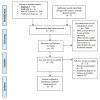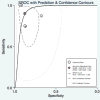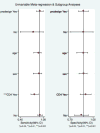Use of transient elastography in patients with HIV-HCV coinfection: A systematic review and meta-analysis
- PMID: 26952020
- PMCID: PMC5014713
- DOI: 10.1111/jgh.13337
Use of transient elastography in patients with HIV-HCV coinfection: A systematic review and meta-analysis
Abstract
Background and aim: Patients with HIV-hepatitis C virus (HCV) coinfection progress towards liver fibrosis and cirrhosis more rapidly compared with HCV mono-infected individuals. This necessitates an accurate assessment of liver stiffness with transient elastography to guide treatment.
Methods: Searches of PubMed, EMBASE, Web of Science, and the Cochrane Library databases were performed through January 2016 to assess the diagnostic accuracy of transient elastography for liver stiffness in the HIV-HCV population. Included studies were analyzed according to the Cochrane DTA Working Group methodology. Bivariate and hierarchical models were used to compute pooled sensitivity and specificity. Positive and negative likelihood ratios were also determined. A Fagan nomogram was constructed. Meta-regression analysis was performed with assessment of publication bias using Deeks' funnel plot asymmetry testing.
Results: A total of six studies (n = 756) met the inclusion criteria. The diagnostic accuracy of elastography for the diagnosis of moderate (≥F2) fibrosis was 88% (95% confidence interval [CI], 0.85-0.90). The pooled sensitivity and specificity of moderate fibrosis was 97% (95% CI, 0.82-0.91) and 64% (95% CI, 0.45-0.79), respectively. The diagnostic accuracy of elastography for the assessment of cirrhosis was 94% (95% CI, 0.91-0.95). The pooled sensitivity and specificity for cirrhosis was 90% (95% CI, 0.74-0.97) and 87% (95% CI, 0.80-0.92), respectively. Meta-regression analysis demonstrated that CD4 cell count did not impact diagnostic accuracy of elastography.
Conclusions: Transient elastography is a noninvasive imaging modality with excellent ability to assess for cirrhosis in patients with HIV-HCV coinfection.
Keywords: HCV; HIV; elastography; fibrosis; hepatitis.
© 2016 Journal of Gastroenterology and Hepatology Foundation and John Wiley & Sons Australia, Ltd.
Conflict of interest statement
Potential Conflicts of Interest: The authors have no potential conflicts of interest to report.
Figures








Similar articles
-
Ultrasound-based transient elastography for the detection of hepatic fibrosis in patients with recurrent hepatitis C virus after liver transplantation: a systematic review and meta-analysis.Liver Transpl. 2012 Mar;18(3):323-31. doi: 10.1002/lt.22460. Liver Transpl. 2012. PMID: 22140010
-
Systematic review with meta-analysis: the diagnostic accuracy of transient elastography for the staging of liver fibrosis in patients with chronic hepatitis B.Aliment Pharmacol Ther. 2016 Feb;43(4):458-69. doi: 10.1111/apt.13488. Epub 2015 Dec 15. Aliment Pharmacol Ther. 2016. PMID: 26669632
-
Performance of transient elastography assessing fibrosis of single hepatitis B virus infection: a systematic review and meta-analysis of a diagnostic test.Hepatol Int. 2015 Oct;9(4):558-66. doi: 10.1007/s12072-015-9643-z. Epub 2015 Jul 18. Hepatol Int. 2015. PMID: 26187292
-
Non-invasive diagnostic assessment tools for the detection of liver fibrosis in patients with suspected alcohol-related liver disease: a systematic review and economic evaluation.Health Technol Assess. 2012;16(4):1-174. doi: 10.3310/hta16040. Health Technol Assess. 2012. PMID: 22333291 Free PMC article.
-
Application of Two-Dimensional Shear Wave Elastography in Evaluating Liver Reserve Function in Patients With Liver Cancer.J Clin Ultrasound. 2025 Sep;53(7):1565-1573. doi: 10.1002/jcu.24015. Epub 2025 Apr 25. J Clin Ultrasound. 2025. PMID: 40277022 Free PMC article.
Cited by
-
Diagnostic performance of APRI and FIB-4 for confirming cirrhosis in Indonesian HIV/HCV co-infected patients.BMC Infect Dis. 2020 May 25;20(1):372. doi: 10.1186/s12879-020-05069-5. BMC Infect Dis. 2020. PMID: 32450844 Free PMC article.
-
Vibration Controlled Transient Elastography (Fibroscan®) in sickle cell liver disease - could we strike while the liver is hard?Br J Haematol. 2019 Oct;187(1):117-123. doi: 10.1111/bjh.16047. Epub 2019 Jun 19. Br J Haematol. 2019. PMID: 31218662 Free PMC article.
-
Elastography for Longitudinal Assessment of Liver Fibrosis after Antiviral Therapy: A Review.J Clin Transl Hepatol. 2020 Dec 28;8(4):445-453. doi: 10.14218/JCTH.2020.00033. Epub 2020 Sep 14. J Clin Transl Hepatol. 2020. PMID: 33447528 Free PMC article. Review.
-
Liver stiffness is not associated with short- and long-term plasma HIV RNA replication in immunocompetent patients with HIV infection and with HIV/HCV coinfection.Ann Gastroenterol. 2017;30(5):534-541. doi: 10.20524/aog.2017.0175. Epub 2017 Jul 4. Ann Gastroenterol. 2017. PMID: 28845109 Free PMC article.
-
Test characteristics for combining non-invasive liver fibrosis staging modalities in individuals with Hepatitis C virus.J Viral Hepat. 2024 Jun;31(6):277-292. doi: 10.1111/jvh.13925. Epub 2024 Feb 7. J Viral Hepat. 2024. PMID: 38326950 Free PMC article.
References
-
- European Association for Study of L. EASL Clinical Practice Guidelines: management of hepatitis C virus infection. Journal of hepatology. 2014;60:392–420. - PubMed
-
- Parkes J, Roderick P, Harris S, et al. Enhanced liver fibrosis test can predict clinical outcomes in patients with chronic liver disease. Gut. 2010;59:1245–51. - PubMed
-
- Panel AIHG. Hepatitis C guidance: AASLD-IDSA recommendations for testing, managing, and treating adults infected with hepatitis C virus. Hepatology. 2015;62:932–54. - PubMed
-
- HIV/AIDS and Viral Hepatitis. Viral Hepatitis - CDC Recommendations for Specific Populations and Settings. [Accessed 16 January 2016]; http://www.cdc.gov/hepatitis/Populations/HIV.htm.
-
- Puoti M, Moioli MC, Travi G, Rossotti R. The burden of liver disease in human immunodeficiency virus-infected patients. Seminars in liver disease. 2012;32:103–13. - PubMed
Publication types
MeSH terms
Grants and funding
LinkOut - more resources
Full Text Sources
Other Literature Sources
Medical
Research Materials
Miscellaneous

